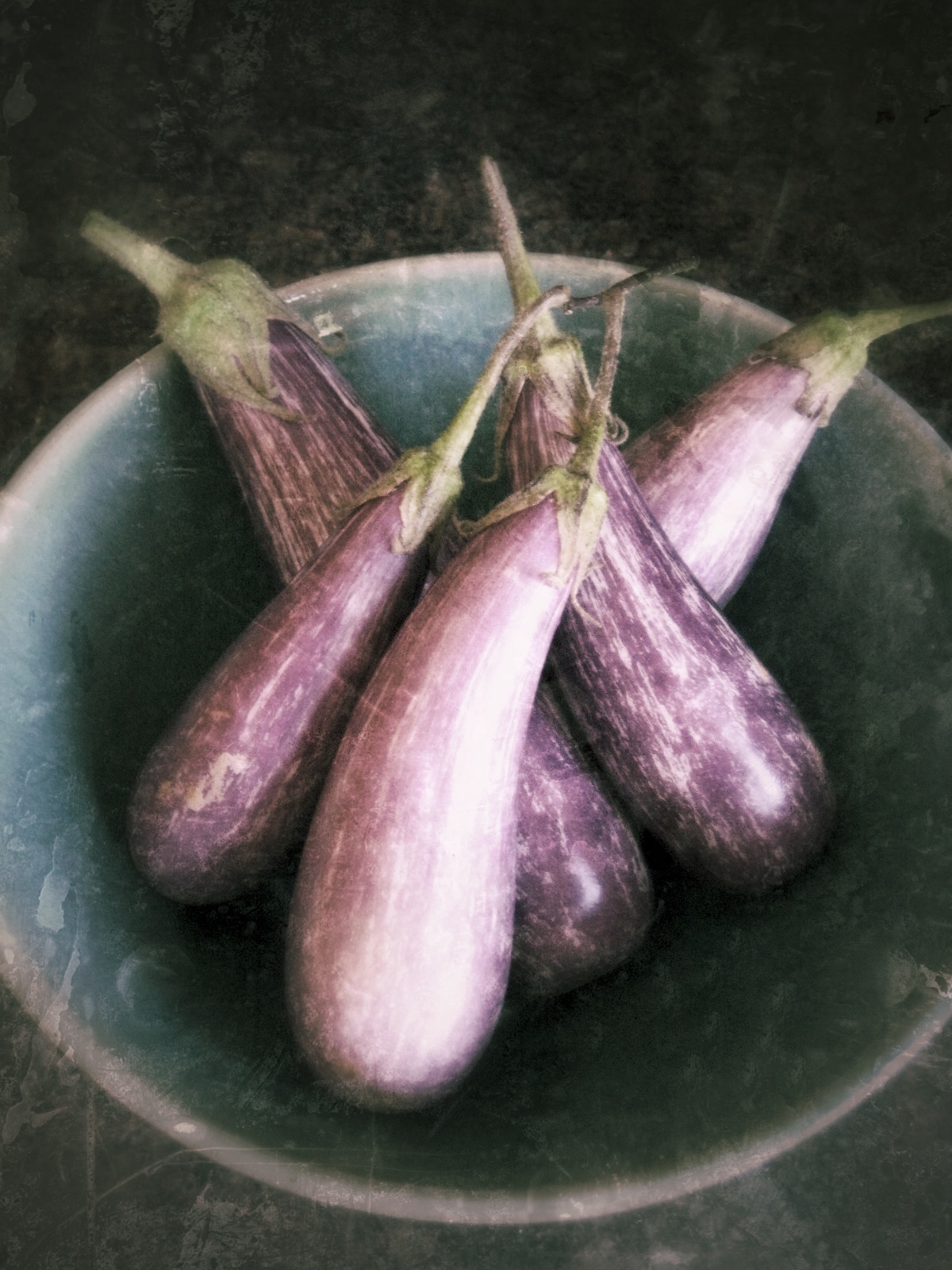I have a long, checkered history with eggplant. I know people who blanch at the mention of it, others that love it in every way. For some reason it fascinates me as one of those vegetables that cries out for finesse and care in how it's handled--nothing complex or difficult, but in need of real discrimination in method and time. I believe it's a sometime victim of bad cooking technique; when done well it's addictive. If not, it can be nasty, a textural disaster.
My first taste of eggplant was a beginner's version, sort of like an experience with training wheels. Eggplant Parmesan (not truly Parmigiano, as in using true Italian Parm) at an Italian-American restaurant, where it was so buried in thick tomato marinara and molten cheese I'm surprised I even knew there was eggplant on the plate. But it was there, with enough meaty texture to distinguish it from the rest of the sauciness, but with no defining flavor of its own (eggplant is often the “meat” in lots of vegetarian recipes). I was sold on the fact that it was a veg-only dish (this was in my college veggie days, when my palate was drowned in eggs and cheese, worried about getting enough protein) in a sea of heavily meat-centric offerings. But my next foray was by way of a vegan boyfriend and a tiny Middle Eastern place that seduced me with their little plates of silky puréed dips. And smoky roasted baba ghanoush, luscious with sesame tahini and a splash of spicy olive oil, bowled me over.
chicken caponata rigatoni (click here for recipe) photo: Dennis Becker
I soon graduated to stewing up a lovely Turkish sweet-and-sour eggplant relish, similar to a Sicilian caponata, that I found in a Sunset cookbook. I served it up as part of appetizer buffets I'd cater for neighbors that entertained a lot. He had worked in California for an agricultural conglomerate that grew scads of cauliflower, lettuce, and other veggies in the central valley. Their interest in my budding culinary skills sent me to San Francisco for a stint in the test kitchens of Dole Foods before I graduated from college.
sizzling deconstructed ratatouille platter (click here for recipe) photo: Dennis Becker
French ratatouille took me down the final road to lovingly embracing anything made with eggplant. Living in Paris, as a student tenant of a generous French family, I had only a two-burner cooktop in a converted closet as a kitchen. Of course I cooked all day at school, so doing much more than heating water for coffee really wasn't of much interest. But when my family was away at their country house in Brittany, I modestly (and on the sly) entertained visiting American friends in their kitchen. I didn't dare do too much, so bought a poulet rôti at the neighborhood market rôtisserie, some of my favorite bread (pain au seigle, a dense rye with walnuts) at the boulangerie, and armloads of late August vegetables at the market. Eggplant and its seasonal cousins, meltingly ripe tomatoes, tender zucchini, and sweetly crisp bell peppers, filled my string shopping bags. A huge bouquet of fragrant basil and some rosemary and fresh garlic followed. I chopped and simmered up a huge pot of ratatouille to serve with the chicken. I'm sure that because I shared the repast with dear friends who brightened a somewhat homesick point in my time abroad, it was probably one of my most memorable meals in France. Oh, and I can't forget one of the best parts was the bottle of Chablis, so different from the innocuous white table wine I'd tasted at home, that cost just a few francs. Its minerally dryness was perfect with the vegetable stew and crispy chicken dripping with rich juices.
I do feel like aubergines follow me around. I stumble upon them grilled on pizza, baked to creaminess alongside hibachi-style teriyaki dishes, shallow-fried with bread crumbs for vastly improved versions of eggplant Parmigiano, or sidling up to a Greek salad or pita-wrapped gyros as a super-garlicky melanzanosalata spread. But maybe it's because the minute I see eggplant as part of a menu or the lynchpin to a simple meal, I'm transported back to lots of other really good times at the table.
To get you started loving this versatile fruit (yes, it’s botanically a fruit, a member of the nightshade family like tomatoes), look for ones that are firm to the touch, have shiny skin and no brown spots. Farmers markets offer up an astonishing variety to explore. Sort through long slender Japanese eggplant, small white round ones (the varietal that looks like fat eggs with stems, the inspiration for the fruit’s name), or rotund globes with purple stripes. Conventional kitchen wisdom is that eggplant skin is inedible—it can be tough on larger ones, but not always. You can decide if you want to peel it off. Other common advice is that its flesh should be salted and allowed to drain away bitterness before cooking, but I’ve found that most eggplant these days don’t need that extra step if you buy them when they’re harvested at their peak in the autumn.



